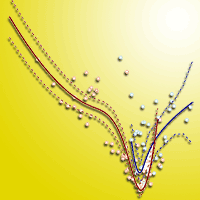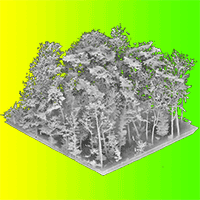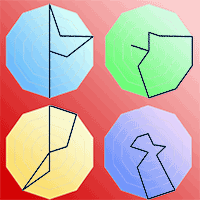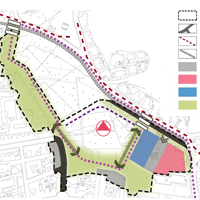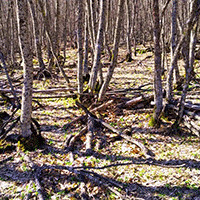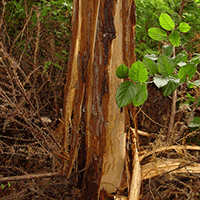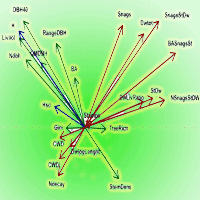Forest ecosystems nowadays provide multiple ecosystem goods and services at a time and throughout all development phases. Species mixing is considered an effective measure to gain benefits beyond purely additive effects. However, the complex structural processes behind interspecific competition and temporal and spatial facilitative effects through mixing are still far from being understood and predictable. In particular the mixture of European beech (Fagus sylvatica L.) and sessile oak (Quercus petraea [Matt.] Liebl.) is gaining even more importance due to the fact that forests from these species are considered more tolerant to climatic effects and are expected to expand their natural range to the north due to global warming. The 30 long-term experimental plots analysed in this study reveal the structural processes in mixed beech-oak stands based on data at the tree and stand level. Using spatial and non-spatial structural indices, we can show an increasing dominance of beech over oak in unmanaged stands and the effectiveness of thinning operations to support oak. Those processes are representative for other light-demanding tree species in mixtures with shade-tolerant species. Improving the knowledge on the structural processes in mixed-species stands is particularly relevant when trying to modify forest structure in order to adapt forest management to shifting environmental conditions and the increasing demand for ecosystem services.
Keywords
, , , , , , ,
Citation
Maleki K, Zeller L, Pretzsch H (2020). Oak often needs to be promoted in mixed beech-oak stands - the structural processes behind competition and silvicultural management in mixed stands of European beech and sessile oak. iForest 13: 80-88. - doi: 10.3832/ifor3172-013
Academic Editor
Giorgio Alberti
Paper history
Received: Jun 19, 2019
Accepted: Jan 02, 2020
First online: Mar 01, 2020
Publication Date: Apr 30, 2020
Publication Time: 1.97 months
© SISEF - The Italian Society of Silviculture and Forest Ecology 2020
Open Access
This article is distributed under the terms of the Creative Commons Attribution-Non Commercial 4.0 International (https://creativecommons.org/licenses/by-nc/4.0/), which permits unrestricted use, distribution, and reproduction in any medium, provided you give appropriate credit to the original author(s) and the source, provide a link to the Creative Commons license, and indicate if changes were made.

Breakdown by View Type
(Waiting for server response...)
Article Usage
Total Article Views: 43332
(from publication date up to now)
Breakdown by View Type
HTML Page Views: 36846
Abstract Page Views: 2895
PDF Downloads: 2837
Citation/Reference Downloads: 12
XML Downloads: 742
Web Metrics
Days since publication: 2100
Overall contacts: 43332
Avg. contacts per week: 144.44
Article Citations
Article citations are based on data periodically collected from the Clarivate Web of Science web site
(last update: Mar 2025)
Total number of cites (since 2020): 19
Average cites per year: 3.17
Publication Metrics
by Dimensions ©
Articles citing this article
List of the papers citing this article based on CrossRef Cited-by.
(1)
Alemdag IS (1978)Evaluation of some competition indexes for the prediction of diameter increment in planted white spruce. Forest Management Institute, Environment Canada, Ottawa, Canada, pp. 39.
Gscholar
(2)
Ammer C (2008)Converting Norway spruce stands with beech - A review of arguments and techniques. Australian Journal of Forest Science 125 (1): 3-26.
Online |
Gscholar
(3)
Bolte A, Czajkowski T, Kompa T (2007)The north-eastern distribution range of European beech a review. Forestry 80 (4): 413-429.
CrossRef |
Gscholar
(4)
Boncina A, Kadunc A, Robic D (2007)Effects of selective thinning on growth and development of beech (
Fagus sylvatica L.) forest stands in south-eastern Slovenia. Annals of Forest Science 64 (1): 47-57.
CrossRef |
Gscholar
(5)
Bontemps J-D, Herve J-C, Duplat P, Dhôte J-F (2012)Shifts in the height-related competitiveness of tree species following recent climate warming and implications for tree community composition. The case of common beech and sessile oak as predominant broadleaved species in Europe. Oikos 121 (8): 1287-1299.
CrossRef |
Gscholar
(6)
Bourdier T, Cordonnier T, Kunstler G, Piedallu C, Lagarrigues G, Courbaud B (2016)Tree size inequality reduces forest productivity: an analysis combining inventory data for ten european species and a light competition model. PloS One 11 (3): 1-14.
CrossRef |
Gscholar
(7)
Clark PJ, Evans FC (1954)Distance to nearest neighbor as a measure of spatial relationships in populations. Ecology 35 (4): 445-453.
CrossRef |
Gscholar
(8)
Danescu A, Albrecht AT, Bauhus J (2016)Structural diversity promotes productivity of mixed, uneven-aged forests in southwestern Germany. Oecologia 182 (2): 319-333.
CrossRef |
Gscholar
(9)
Diggle PJ (2003)Statistical analysis of spatial point patterns (2nd edn). Arnold, London, UK, pp. 159.
Gscholar
(10)
Emborg J (1998)Understorey light conditions and regeneration with respect to the structural dynamics of a near-natural temperate deciduous forest in Denmark. Forest Ecology and Management 106 (2-3): 83-95.
CrossRef |
Gscholar
(11)
Fahrmeir L, Jung S (2001)Bayesian inference for generalized additive mixed models based on Markov random field priors. Applied Statistics 50: 201-220.
CrossRef |
Gscholar
(12)
Franz F, Bachler J, Deckelmann B, Kennel E, Kennel R, Schmidt A, Wotschikowsky U (1973)Bayrische Waldinventur 1970/71 - Aufnahme und Auswertungsverfahren. [The Bavarian forest inventory 1970/71 - Measuring and analysis]. Forschungsbericht 11: 141. [in German]
Gscholar
(13)
Frech A (2006)Walddynamik in Mischwäldern des Nationalparks Hainich [Forest dynamics in mixed forests in the National park Hainich]. Univ. Dissertation, Forschungszentrum Waldökosysteme der Universität, Göttingen, Germany, pp. 120. [in German]
Gscholar
(14)
Füldner K (1995)Strukturbeschreibung von Buchen-Edellaubholz-Mischwäldern [Structure in mixed forests of beech and other hardwoods]. Univ. Dissertation, Cuvillier, Göttingen, Germany, pp. 146. [in German]
Gscholar
(15)
Gamfeldt L, Snäll T, Bagchi R, Jonsson M, Gustafsson L, Kjellander P, Ruiz-Jaen MC, Fröberg M, Stendahl J, Philipson CD, Mikusinski G, Andersson E, Westerlund B, Andrén H, Moberg F, Moen J, Bengtsson J (2013)Higher levels of multiple ecosystem services are found in forests with more tree species. Nature Communications 4 (1): 59.
CrossRef |
Gscholar
(16)
Hamilton TH (1968)The theory of island biogeography. Robert H. MacArthur and Edward O. Wilson. Science 159 (3810): 71-72.
CrossRef |
Gscholar
(17)
Hegyi F (1974)A simulation model for managing jackpine stands. Growth models for tree and stand simulation. Royal College of Forestry, Stockholm, Sweden, pp. 74-90.
Gscholar
(18)
Hein S, Dhôte J-F (2006)Effect of species composition, stand density and site index on the basal area increment of oak trees (
Quercus sp.) in mixed stands with beech (
Fagus sylvatica L.) in northern France. Annales des Sciences Forestières 5 (63): 457-467.
CrossRef |
Gscholar
(19)
Hui GY, Von Gadow K (2002)Das Winkelmaß. Herleitung des optimalen Standardwinkels. [The uniform angle index. Derivation of the optimal standard angle]. Allgemeine Forst und Jagdzeitung 173: 173-177.
Gscholar
(20)
Larsen DR, Johnson PS (1998)Linking the ecology of natural oak regeneration to silviculture. Forest Ecology and Management 106 (1): 1-7.
CrossRef |
Gscholar
(21)
Leuschner C, Hertel D, Coners H, Büttner V (2001)Root competition between beech and oak. A hypothesis. Oecologia 126 (2): 276-284.
CrossRef |
Gscholar
(22)
Liang J, Crowther TW, Picard N, Wiser S, Zhou M, Alberti G, Schulze ED, Mcguire AD, Bozzato F, Pretzsch H, de-Miguel S, Paquette A, Herault B, Scherer-Lorenzen M, Barrett CB, Glick HB, Hengeveld GM, Nabuurs GJ, Pfautsch S, Viana H, Vibrans AC, Ammer C, Schall P, Verbyla D, Tchebakova N, Fischer M, Watson JV, Chen HY, Lei X, Schelhaas MJ, Lu H, Gianelle D, Parfenova EI, Salas C, Lee E, Lee B, Kim HS, Bruelheide H, Coomes DA, Piotto D, Sunderland T, Schmid B, Gourlet-Fleury S, Sonke B, Tavani R, Zhu J, Brandl S, Vayreda J, Kitahara F, Searle EB, Neldner VJ, Ngugi MR, Baraloto C, Frizzera L, Balazy R, Oleksyn J, Zawila-Niedzwiecki T, Bouriaud O, Bussotti F, Finer L, Jaroszewicz B, Jucker T, Valladares F, Jagodzinski AM, Peri PL, Gonmadje C, Marthy W, Obrien T, Martin EH, Marshall AR, Rovero F, Bitariho R, Niklaus PA, Alvarez-Loayza P, Chamuya N, Valencia R, Mortier F, Wortel V, Engone-Obiang NL, Ferreira LV, Odeke DE, Vasquez RM, Lewis SL, Reich PB (2016)Positive biodiversity-productivity relationship predominant in global forests. Science 354 (6309): aaf8957.
CrossRef |
Gscholar
(23)
Ligot G, Balandier P, Fayolle A, Lejeune P, Claessens H (2013)Height competition between
Quercus petraea and
Fagus sylvatica natural regeneration in mixed and uneven-aged stands. Forest Ecology and Management 304: 391-398.
CrossRef |
Gscholar
(24)
Longuetaud F, Seifert T, Leban J-M, Pretzsch H (2008)Analysis of long-term dynamics of crowns of sessile oaks at the stand level by means of spatial statistics. Forest Ecology and Management 255 (5): 2007-2019.
CrossRef |
Gscholar
(25)
Mensah S, Du Toit B, Seifert T (2018)Diversity-biomass relationship across forest layers: implications for niche complementarity and selection effects. Oecologia 187 (3): 783-795.
CrossRef |
Gscholar
(26)
Mizunaga H, Nagaike T, Yoshida T, Valkonen S (2010)Feasibility of silviculture for complex stand structures: designing stand structures for sustainability and multiple objectives. Journal of Forest Research 15 (1): 1-2.
CrossRef |
Gscholar
(27)
Pielou EC (1959)The use of point-to-plant distances in the study of the pattern of plant populations. Journal of Ecology 47 (3): 607.
CrossRef |
Gscholar
(28)
Pielou EC (1977)Mathematical ecology (2nd edn). Wiley-Interscience, John Wiley and Sons, NY, USA, pp. 385.
Gscholar
(29)
Pommerening A (2002)Approaches to quantifying forest structures. Forestry 75 (3): 305-324.
CrossRef |
Gscholar
(30)
Pretzsch H (1992)Konzeption und Konstruktion von Wuchsmodellen für Rein- und Mischbestände [Concept and construction of growth models for pure and mixed stands]. Chair of Forest Growth at Ludwig-Maximilians-University Munich, Germany, pp. 339. [in German]
Gscholar
(31)
Pretzsch H (1998)Structural diversity as a result of silvicultural operations. Lesnictvi-Forestry 44 (10): 429-439.
Gscholar
(32)
Pretzsch H (2009)Forest dynamics, growth and yield. From measurement to model. Springer, Berlin, Germany, pp. 664.
Online |
Gscholar
(33)
Pretzsch H, Biber P (2010)Size-symmetric versus size-asymmetric competition and growth partitioning among trees in forest stands along an ecological gradient in central Europe. Canadian Journal of Forest Research 40 (2): 370-384.
CrossRef |
Gscholar
(34)
Pretzsch H, Bielak K, Block J, Bruchwald A, Dieler J, Ehrhart HP, Kohnle U, Nagel J, Spellmann H, Zasada M, Zingg A (2013)Productivity of mixed
versus pure stands of oak (
Quercus petraea (Matt.) Liebl. and
Quercus robur L.) and European beech (
Fagus sylvatica L.) along an ecological gradient. European Journal of Forest Research 132 (2): 263-280.
CrossRef |
Gscholar
(35)
Pretzsch H, Zenner EK (2017)Toward managing mixed-species stands. From parametrization to prescription. Forest Ecosystems 4 (1): 19.
CrossRef |
Gscholar
(36)
Pretzsch H, del Río M, Biber P, Arcangeli C, Bielak K, Brang P, Dudzinska M, Forrester DI, Klädtke J, Kohnle U, Ledermann T, Matthews R, Nagel J, Nagel R, Nilsson U, Ningre F, Nord-Larsen T, Wernsdörfer H, Sycheva E (2019)Maintenance of long-term experiments for unique insights into forest growth dynamics and trends: review and perspectives. European Journal of Forest Research 138 (1): 165-185.
CrossRef |
Gscholar
(37)
R Core Team (2018)R: a language and environment for statistical computing. R Foundation for Statistical Computing, Vienna, Austria.
Online |
Gscholar
(38)
Radtke PJ, Burkhart HE (1998)A comparison of methods for edge-bias compensation. Canadian Journal of Forest Research 28 (6): 942-945.
CrossRef |
Gscholar
(39)
Reineke LH (1933)Perfecting a stand-density index for even-aged forests. Journal for Agricultural Research 46: 627-638.
Gscholar
(40)
Ripley BD (1981)Spatial statistics. Series “Applied Probability and Statistics”, John Wiley and Sons, NY, USA, pp. 260.
Gscholar
(41)
Rubio-Cuadrado A, Camarero JJ, Del Río M, Sánchez-González M, Ruiz-Peinado R, Bravo-Oviedo A, Gil L, Montes F (2018)Drought modifies tree competitiveness in an oak-beech temperate forest. Forest Ecology and Management 429: 7-17.
CrossRef |
Gscholar
(42)
Seifert T, Seifert S, Seydack A, Durrheim G, Von Gadow K (2014)Competition effects in an afrotemperate forest. Forest Ecosystems 1 (1): 707.
CrossRef |
Gscholar
(43)
Stiers M, Willim K, Seidel D, Ehbrecht M, Kabal M, Ammer C, Annighöfer P (2018)A quantitative comparison of the structural complexity of managed, lately unmanaged and primary European beech (
Fagus sylvatica L.) forests. Forest Ecology and Management 430: 357-365.
CrossRef |
Gscholar
(44)
Szwagrzyk J, Szewczyk J (2001)Tree mortality and effects of release from competition in an old-growth
Fagus-Abies-Picea stand. Journal of Vegetation Science 12 (5): 621-626.
CrossRef |
Gscholar
(45)
Vacek S, Lepš J (1996)Spatial dynamics of forest decline. The role of neighbouring trees. Journal of Vegetation Science 7 (6): 789-798.
CrossRef |
Gscholar
(46)
Varga A, Ódor P, Molnár Z, Bölöni J (2015)The history and natural regeneration of a secondary oak-beech woodland on a former wood-pasture in Hungary. Acta Societatis Botanicorum Poloniae 84 (2): 215-225.
CrossRef |
Gscholar
(47)
Von Gadow K, Hui G (2002)Characterizing forest spatial structure and diversity. In: Proceedings of the IUFRO International Workshop: “Sustainable Forestry in Temperate Regions”. University of Lund (Lund, Sweden) 7-9 Apr 2002, pp. 20-30.
Online |
Gscholar
(48)
Von Lüpke B (1998)Silvicultural methods of oak regeneration with special respect to shade tolerant mixed species. Forest Ecology and Management 106 (1): 19-26.
CrossRef |
Gscholar
(49)
Zeller L, Pretzsch H (2019)Effect of forest structure on stand productivity in Central European forests depends on developmental stage and tree species diversity. Forest Ecology and Management 434: 193-204.
CrossRef |
Gscholar
(50)
Zellweger F, Braunisch V, Baltensweiler A, Bollmann K (2013)Remotely sensed forest structural complexity predicts multi species occurrence at the landscape scale. Forest Ecology and Management 307 (2013): 303-312.
CrossRef |
Gscholar
